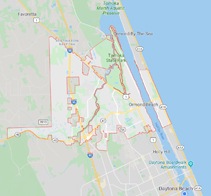News Archives
Sea turtle nesting season starts May 1 in Volusia County.
Written by Kristen Schmutz
Belden Communications News
Sea turtle nesting season begins May 1 through October 31, with 400 to 500 nests anticipated to be laid throughout Volusia County in a typical year. Volusia County-managed beaches already have three sea turtle nests, one leatherback sea turtle, and two Kemp’s ridleys sea turtle nests, the world’s smallest and most endangered sea turtle species.
According to a release, the first nest was the leatherback sea turtle nest, which was discovered on March 29, 2023, the earliest recorded sea turtle nest to date.
Nesting season is when sea turtles come from the sea to lay eggs on the beach. After incubating in the sand for about two months, tiny hatchlings will break free of their eggshells and make a treacherous crawl to the ocean, dodging predators, holes, trash, and beach furniture. Tragically, some will also be led into harm’s way by beachfront lighting. Officials estimate that only about one in 1,000 to 10,000 hatchlings will make it safely to sexual maturity, which may take 10 to 25 years.
“Our goal is to make Volusia County beaches a safe and inviting place for humans and sea turtles,” said Jaymie Reneker, Volusia County’s Sea Turtle Habitat Conservation Plan program manager. “We encourage residents and visitors alike to respect our wildlife. The largest impact even a single person can make is keeping our beaches clean, dark, and flat. We encourage everyone to let the night provide the light on our coastline.”
Oceanfront property owners must shield, redirect, or turn off lights from shining on the beach, as female and hatchling sea turtles can be affected by artificial lighting. Typically, female sea turtles choose dark, naturally moonlit beaches to deposit their eggs. After emerging from their nest, hatchling sea turtles navigate to the sea using the moon reflecting off the water.
“Visitors and residents can help by turning lights off when not in use, using blinds to block interior lights, and redirecting lights away from the beach,” Reneker said. “This will help keep sea turtles out of danger all season long.”
Residents may also help by applying to the following dos and don’ts list:
- Do not touch or disturb sea turtles or their nests. Hatchlings must make their way to the ocean.
- Do not disturb the dune system or plants. Use designated beach access points, and do not walk on the dunes.
- When driving on the beach, use the designated traffic lanes and parking areas. Beach driving access hours are from 8 a.m. to 7 p.m. throughout the nesting season, tide permitting.
- Do not use flash photography at night.
- Do not use cell phones to light your way at night.
- Use only red LED flashlights; they are less visible to turtle eyes.
- After a day at the beach, flatten sandcastles, fill in holes, and take your chairs and equipment home. This is an easy way to reduce obstacles faced by sea turtles.
- Dispose of trash and recyclables in proper receptacles. Trash left on the beach can attract predators that impact sea turtle nests.
- Do not use fireworks. They are prohibited on the beach and can be disruptive to turtles.
- If you see a nesting adult sea turtle or hatchlings making their way to the ocean, admire them from a safe distance. Stand far away, remain calm, and quietly enjoy this experience. If a turtle appears to be in immediate danger, notify a lifeguard or Beach Safety officer or call the Florida Fish and Wildlife Conservation Commission at 888-404-3922.
For more information, call (386)238-4668 or visit www.volusiaseaturtles.org.




